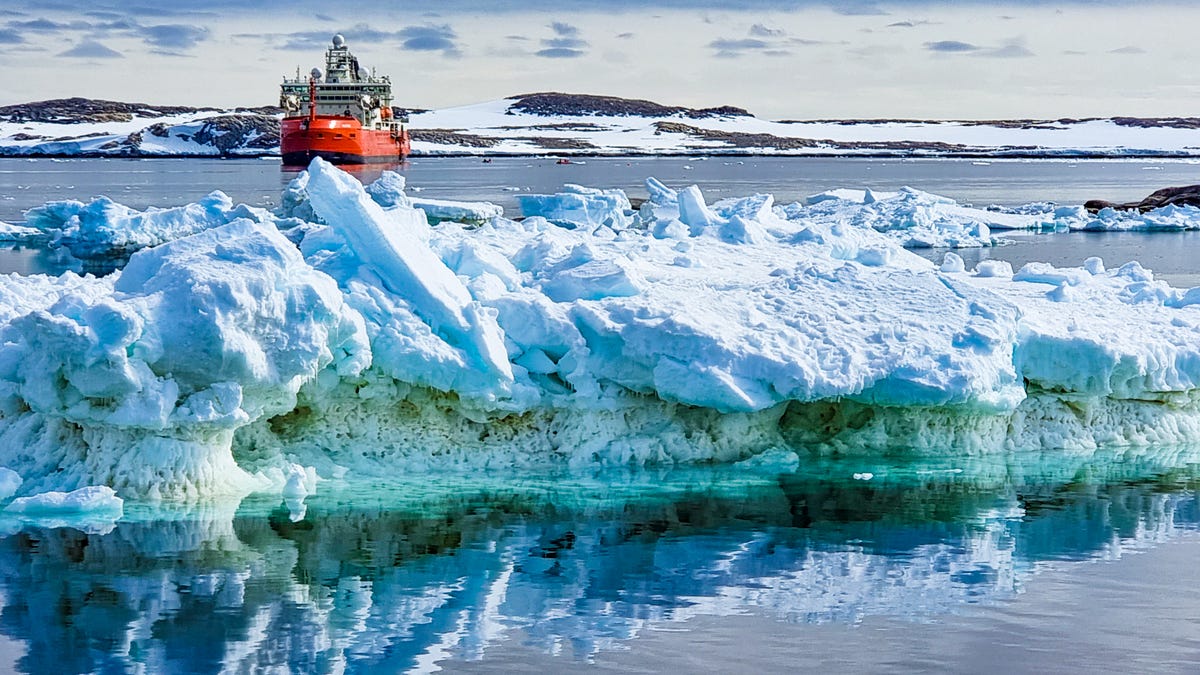Antarctica Is Melting Faster Thanks to Pollution From Tourism and Research
Black carbon pollution from ships and around research stations is causing snow to disappear faster in some spots on Antarctica.

Australia's research and supply vessel, the RSV Nuyina, in Newcomb Bay, Antarctica.
In the coldest place on Earth, the temperature is rising. Human-induced climate change is causing Antarctica to experience heat like it hasn't seen before, especially on the Antarctic peninsula -- one of the fastest warming regions on the planet.
While greenhouse gas emissions are responsible for drastic, potentially irreversible changes to the continent's ice sheets, human pollution is also threatening to increase melting in the icy south. In a study, published in the journal Nature Communications on Feb. 22, researchers suggest that increasing tourism and research activities in Antarctica could result in a loss of up to 83 tons of snow each summer thanks to dirty black carbon.
You're no doubt familiar with carbon dioxide, the greenhouse gas that's the chief driver behind human-induced climate change and pumped into the atmosphere via burning fossil fuels. The gas hangs around in the atmosphere and traps heat from our sun, over time turning up the temperature on Earth. But burning fossil fuels (and other dirty combustion processes) also creates "black carbon," or soot -- tiny, impure chunks of carbon that absorb sunlight.
It doesn't hang around quite like carbon dioxide does, but when black carbon settles on Antarctica, the white snow loses its ability to reflect sunlight, leading to a local increase in heat that causes melting.
The researchers assessed the amount of black carbon present in snow collected across a 1,200-mile stretch of Antarctica. They started at the tip of the Antarctic peninsula, on the continent's western side, and went as deep into the interior interior as Union Glacier, home to a Chilean base and a private camp where tourists can stay out on the ice. Union Glacier is also where the Antarctic marathon takes place each summer.
Across four summer seasons between 2016 and 2020, they nabbed 155 snow samples at 28 different sites. Some of the sampling sites included areas near research facilities such as Deception Island, home to Argentinian and Spanish bases, and places like Petermann Island, where vessels allow tourists on shore.
The samples revealed black carbon concentrations "considerably above" those found in unoccupied regions of the continent. The Antarctic peninsula showed the highest concentrations, with the Trinity peninsula showing the highest levels of soot. Trinity is home to both the Chilean O'Higgins base and Argentina's Esperanza base which, in 2020, recorded the highest temperature on Antarctica yet seen. Worryingly, even the sampled region near Union Glacier was showing signs of increased black carbon.
The team reasoned that the reduction in reflectiveness because of black carbon is quite low but could still result in the snowpack shrinking by almost one inch every summer. They also tried to put a figure on how much an average researcher or visitor might contribute to melting snow and found that the average expeditioner at a research station in particular regions of Antarctica could accelerate melting of between 300 and 900 tons of snow each season.
There are a few assumptions baked into these figures, but they provide a starting point in understanding how our activities in the Antarctic adversely affect the environment. In something of a silver lining, the researchers write that humanity's black carbon footprint was likely even higher a decade ago, before heavy fuel was banned in the Antarctic and ships moved to a more efficient diesel blend.
They call for the International Association of Antarctica Tour Operators to "limit tourist activity and continue to push for a faster transition to clean fuel and hybrid or electric ships" and suggest that Antarctic programs should limit the size of their research sites on the continent.

